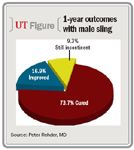Article
Transobturator sling for post-radical prostatectomy stress urinary incontinence safe, efficacious
Men with mild to moderate stress incontinence following radical prostatectomy may find relief with a newer-generation male sling.

Key Points

The latest follow-up data, presented at the AUA annual meeting in San Francisco, showed good outcomes with the AdVance Male Sling (American Medical Systems, Minnetonka, MN), a transobturator retroluminal repositioning sling. The AdVance sling was developed by first author Peter Rehder, MD, and Christian Gozzi, MD.
"We found that patients who were best suited for this repositioning sling had an uncomplicated radical prostatectomy with no other treatments and mild to moderate incontinence," reported Dr. Rehder, chief of reconstructive urology, Medical University Innsbruck, Innsbruck, Austria. "We examined 1 year of data on 118 patients with the sling. The correct positioning of the middle piece of the sling is critical for a good outcome."

High rate of success at 1 year
At 12 months after implantation, 73.7% of the 118 patients in the study were cured of stress urinary incontinence and 16.9% showed measurable improvement. Only 9.3% were still incontinent. Daily pad use as reported by patients decreased significantly after sling placement (p<.01), and scores on the short form of the International Consultation on Incontinence Modular Questionnaire improved significantly compared to pre-sling scores (p<.01).
Valsalva leak point pressure improved significantly after the sling was placed, while detrusor voiding pressure, postvoid residual urine volume, and maximal peak flow rates all remained unchanged (p<.01), Dr. Rehder's group reported.
There were no major complications in any of the patients in the treatment group. Adverse events included transient scrotal pain or perineal discomfort in 19.5% of patients. Postoperative urinary retention was observed in 5.1% of patients, but retention resolved spontaneously in all patients after a few weeks of catheter use. A few men, 1.7%, reported adductor pain, but the pain resolved spontaneously in all patients.
Sling provides support without pressure
There can be a relaxation of the posterior sphincter to the point of urethral prolapse following radical prostatectomy, Dr. Rehder noted. Men with severe incontinence following prostatectomy may suffer prolapse of the entire perineum. Most slings designed to ease stress incontinence in men press across the urethra and may compress the lumen. The transobturator retroluminal repositioning sling is designed to provide proximal support to the posterior support structures of the urinary sphincter. It elevates by applying pressure parallel to the urethra. It does not obstruct the urethra, even when pulled tight, because the urethra dips below the symphysis pubis.
"What is critical is that the lift of the sling does not compress the urethral wall but supports it in a hammock kind of method," Dr. Rehder said. "By supporting the distal part of the membranous urethra, the residual sphincter mechanism is enabled to functionally occlude the urethral lumen."
Dr. Rehder said the most important aspect of using the sling is patient selection.
"The best way to diagnose patients with good residual sphincter function is performing a dynamic urethroscopy," he explained. "The concentric coaptive sphincter response during non-compressive midperineal elevation, leading to lengthening of the functional urethra, predicts good post-op outcome."
Dr. Rehder said that he and his team expect to see wider application of the sling with the emergence of robot-assisted surgery.
"Robots tend to cause less damage to the urethra and sphincter and make the sling a more practical treatment for more men," he said.
Newsletter
Stay current with the latest urology news and practice-changing insights — sign up now for the essential updates every urologist needs.
















